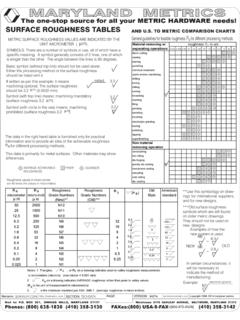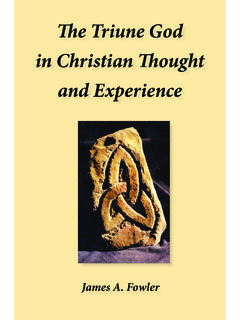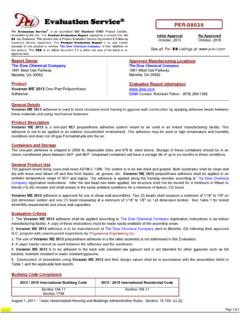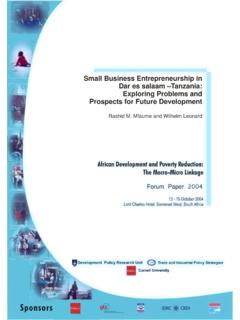Transcription of This page intentionally left blank - UNAM
1 this page intentionally left blankCondensed Matter Field TheorySecond editionModern experimental developments in condensed matter and ultracold atom physics presentformidable challenges to theorists. this book provides a pedagogical introduction to quan-tum field theory in many particle physics, emphasizing the applicability of the formalismto concrete second edition contains two new chapters developing path integral approaches toclassical and quantum nonequilibrium phenomena. Other chapters cover a range of topics,from the introduction of many-body techniques and functional integration, to renormaliza-tion group methods, the theory of response functions, and topology. Conceptual aspects andformal methodology are emphasized, but the discussion focuses on practical experimentalapplications drawn largely from condensed matter physics and neighboring and challenging problems with fully worked solutions provide a bridge betweenformal manipulations and research-oriented thinking.
2 Aimed at elevating graduate studentsto a level where they can engage in independent research, this book complements graduatelevel courses on many particle Professor of Theoretical Condensed Matter Physics at the Instituteof Theoretical Physics, University of K oln. His main areas of research include mesoscopicphysics, the physics of interacting many particle systems, and quantum nonlinear Professor of Theoretical Condensed Matter Physics at theCavendish Laboratory, University of Cambridge. His main areas of research include stronglycorrelated condensed matter systems, mesoscopic and ultracold atom Matter Field TheorySecond editionAlexander Altland and Ben SimonsCAMBRIDGE UNIVERSITY PRESSC ambridge, New York, Melbourne, Madrid, Cape Town, Singapore,S o Paulo, Delhi, Dubai, TokyoCambridge University PressThe Edinburgh Building, Cambridge CB2 8RU, UKFirst published in print formatISBN-13 978-0-521-76975-4 ISBN-13 978-0-511-78928-1 A.
3 Altland and B. Simons 20102010 Information on this title: publication is in copyright. Subject to statutory exception and to the provision of relevant collective licensing agreements, no reproduction of any partmay take place without the written permission of Cambridge University University Press has no responsibility for the persistence or accuracy of urls for external or third-party internet websites referred to in this publication, and does not guarantee that any content on such websites is, or will remain, accurate or in the United States of America by Cambridge University Press, New (NetLibrary)HardbackContentsPrefacepagei x1 From particles to Classical harmonic chain.
4 Functional analysis and variational Maxwell s equations as a variational Quantum Quantum Noether s Summary and Problems352 Second Introduction to second Applications of second Summary and Problems833 Feynman path The path integral: general Construction of the path Applications of the Feynman path Problems1464 Functional field Construction of the many-body path Field integral for the quantum partition Field theoretical bosonization: a case Summary and Problems1815 Perturbation General structures and low-order Ground state energy of the interacting electron Infinite-order Summary and Problems2336 Broken symmetry and collective Mean-field Plasma theory of the interacting electron Bose Einstein condensation and Field theory of the disordered electron Summary and Problems3317 Response Crash course in modern experimental Linear response Analytic structure of correlation Electromagnetic linear Summary and Problems4008 The renormalization The one-dimensional Ising Dissipative quantum Renormalization group.
5 General RG analysis of the ferromagnetic RG analysis of the nonlinear Berezinskii Kosterlitz Thouless Summary and Problems4759 Example: particle on a Wess Zumino Chern Simons Summary and Problems58810 Nonequilibrium (classical) Fundamental questions of (nonequilibrium) statistical Langevin Boltzmann kinetic Stochastic Field theory I: zero dimensional Field theory II: higher Field theory III: Summary and Problems68411 Nonequilibrium (quantum) Prelude: Quantum master Keldysh formalism: Particle coupled to an Fermion Keldysh theory (a list of changes) Kinetic A mesoscopic Full counting Summary and Problems753 Index766 PrefaceIn the past few decades, the field of quantum condensed matter physics has seen rapidand, at times, almost revolutionary development.
6 Undoubtedly, the success of the fieldowes much to ground-breaking advances in experiment: already the controlled fabricationof phase coherent electron devices on the nanoscale is commonplace (if not yet routine),while the realization of ultra cold atomic gases presents a new arena in which to explorestrong interaction and condensation phenomena in Fermi and Bose systems. These, alongwith many other examples, have opened entirely new perspectives on the quantum physicsof many-particle systems. Yet, important as it is, experimental progress alone does not,perhaps, fully explain the appeal of modern condensed matter physics. Indeed, in concertwith these experimental developments, there has been a quiet revolution in condensedmatter theory, which has seen phenomena in seemingly quite different systems united bycommon physical mechanisms.
7 this relentless unification of condensed matter theory,which has drawn increasingly on the language of low-energy quantum field theory, betraysthe astonishing degree ofuniversality, not fully appreciated in the early a truly microscopic level, all forms of quantum matter can be formulated as a many-body Hamiltonian encoding the fundamental interactions of the constituent particles. How-ever, in contrast with many other areas of physics, in practically all cases of interest incondensed matter the structure of this operator conveys as much information about theproperties of the system as, say, the knowledge of the basic chemical constituents tells usabout the behavior of a living organism!
8 Rather, in the condensed matter environment,it has been a long-standing tenet that the degrees of freedom relevant to the low-energyproperties of a system are very often not the microscopic. Although, in earlier times, thepassage between the microscopic degrees of freedom and the relevant low-energy degrees offreedom has remained more or less transparent, in recent years this situation has changedprofoundly. It is a hallmark of many deep problems of modern condensed matter physicsthat the connection between the two levels involves complex and, at times, even controversialmappings. To understand why, it is helpful to place these ideas on a firmer , the development of modern condensed matter physics has, to a large extent,hinged on the unreasonable success and notorious failures ofnon-interactingtheo-ries.
9 The apparent impotency of interactions observed in a wide range of physical sys-tems can be attributed to a deep and far-reaching principle ofadiabatic continuity:theixxquantum numbers that characterize a many-body system are determined by fundamen-tal symmetries (translation, rotation, particle exchange, etc.). Providing that the integrityof the symmetries is maintained, the elementary quasi-particle excitations of an inter-acting system can be usually traced back adiabatically to those of the bare particleexcitations present in the non-interacting system. Formally, one can say that the radiusof convergence of perturbation theory extends beyond the region in which the pertur-bation is small.
10 For example, thisquasi-particle correspondence, embodied in Landau sFermi-liquid theory, has provided a reliable platform for the investigation of the widerange of Fermi systems from conventional metals to3helium fluids and cold atomic , being contingent on symmetry, the principle of adiabatic continuity and, withit, the quasi-particle correspondence, must be abandoned at aphase transition. Here, inter-actions typically effect a substantial rearrangement of the many-body ground state. In thesymmetry-broken phase, a system may and frequently does exhibit elementary exci-tations very different from those of the parent non-interacting phase. These elementaryexcitations may be classified as new species of quasi-particle with their own characteristicquantum numbers, or they may represent a new kind of excitation a collective mode engaging the cooperative motion of many bare particles.








